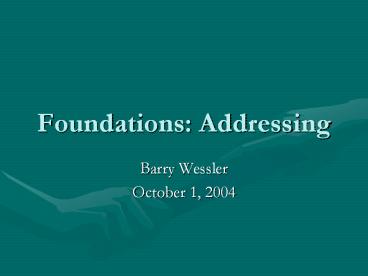Foundations:%20Addressing - PowerPoint PPT Presentation
Title:
Foundations:%20Addressing
Description:
Limited Huffman coding (country codes and area codes in some countries) ... Part physical address to the final recipient or functional area. Addressing was local ... – PowerPoint PPT presentation
Number of Views:160
Avg rating:3.0/5.0
Title: Foundations:%20Addressing
1
Foundations Addressing
- Barry Wessler
- October 1, 2004
2
The Postal Letter
- Variable length
- Subaddressing
- Descriptive
- Field oriented
- Redundancy (zip code)
- Limited automation (OCR, ZIP)
- Global Standard
3
Circuit Switch
- Telex, telephone, X.25 (virtual circuits)
- Numeric
- Variable length (but fixed maximum)
- Limited Huffman coding (country codes and area
codes in some countries) - Historically geo-coded numbering but some
breakdown today due to mobile services
4
Message Switching
- Telex store-and-forward
- Generally hybrid addressing
- Part numeric to a distribution center
- Part physical address to the final recipient or
functional area - Addressing was local
5
Packet Services
- Three original ARPANet application models
- Person-to-person (RWT)
- Computer-to-computer (LGR)
- Person-to-computer (BDW)
6
Basic Justification LGR Analysis
Unit cost
Transmission
Computing
Time
7
Original Scale
- 30 to 50 nodes planned
- 50 Kbs lines between nodes
- Less than 100 bytes average packet size
- ARPA IPT contractors and selected defense
establishments - RD money used not implementation or operation
money
8
ARPANet Addressing
- Specified in BBN 1822 interface document
- Fixed length (6 bits) node addressing
- Subaddressing (2 bits)
- Total of 256 addressable points
- Later changed to 16 bit node addressing and 8 bit
subaddressing (1976)
9
Early ARPANet Map
10
Later Map
11
Later Map
12
System Complexity
Complexity
Time
13
Addressing for Internet 0
- Always use existing protocols if rational and
possible - If not, try to predict end point complexity and
plateaus and design accordingly































